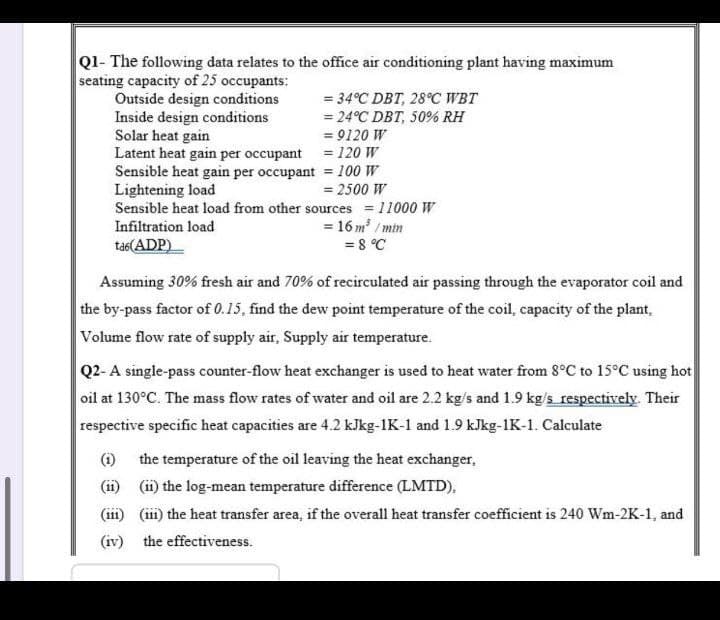Q2- A single-pass counter-flow heat exchanger is used to heat water from 8°C to 15°C using hot oil at 130°C. The mass flow rates of water and oil are 2.2 kg/s and 1.9 kg/s respectively. Their respective specific heat capacities are 4.2 kJkg-1K-1 and 1.9 kJkg-1K-1. Calculate (1) the temperature of the oil leaving the heat exchanger, (i1) (i1) the log-mean temperature difference (LMTD), (i11) (ii1) the heat transfer area, if the overall heat transfer coefficient is 240 Wm-2K-1, and (iv) the effectiveness.
Q2- A single-pass counter-flow heat exchanger is used to heat water from 8°C to 15°C using hot oil at 130°C. The mass flow rates of water and oil are 2.2 kg/s and 1.9 kg/s respectively. Their respective specific heat capacities are 4.2 kJkg-1K-1 and 1.9 kJkg-1K-1. Calculate (1) the temperature of the oil leaving the heat exchanger, (i1) (i1) the log-mean temperature difference (LMTD), (i11) (ii1) the heat transfer area, if the overall heat transfer coefficient is 240 Wm-2K-1, and (iv) the effectiveness.
Principles of Heat Transfer (Activate Learning with these NEW titles from Engineering!)
8th Edition
ISBN:9781305387102
Author:Kreith, Frank; Manglik, Raj M.
Publisher:Kreith, Frank; Manglik, Raj M.
Chapter6: Forced Convection Over Exterior Surfaces
Section: Chapter Questions
Problem 6.2DP
Related questions
Question
I need to solve question 2.

Transcribed Image Text:QI- The following data relates to the office air conditioning plant having maximum
seating capacity of 25 occupants:
Outside design conditions
Inside design conditions
Solar heat gain
Latent heat gain per occupant = 120 W
Sensible heat gain per occupant = 100 W
Lightening load
Sensible heat load from other sources = 11000 W
= 34°C DBT, 28°C WBT
= 24°C DBT, 50% RH
= 9120 W
= 2500 W
Infiltration load
= 16 m / min
tas(ADP)
= 8 °C
Assuming 30% fresh air and 70% of recirculated air passing through the evaporator coil and
the by-pass factor of 0.15, find the dew point temperature of the coil, capacity of the plant,
Volume flow rate of supply air, Supply air temperature.
Q2-A single-pass counter-flow heat exchanger is used to heat water from 8°C to 15°C using hot
oil at 130°C. The mass flow rates of water and oil are 2.2 kg/s and 1.9 kg/s respectively. Their
respective specific heat capacities are 4.2 kJkg-1K-1 and 1.9 kJkg-1K-1. Calculate
(1) the temperature of the oil leaving the heat exchanger,
(ii) (ii) the log-mean temperature difference (LMTD),
(iin) (ii1) the heat transfer area, if the overall heat transfer coefficient is 240 Wm-2K-1, and
(iv) the effectiveness.
Expert Solution
This question has been solved!
Explore an expertly crafted, step-by-step solution for a thorough understanding of key concepts.
This is a popular solution!
Trending now
This is a popular solution!
Step by step
Solved in 2 steps with 3 images

Knowledge Booster
Learn more about
Need a deep-dive on the concept behind this application? Look no further. Learn more about this topic, mechanical-engineering and related others by exploring similar questions and additional content below.Recommended textbooks for you

Principles of Heat Transfer (Activate Learning wi…
Mechanical Engineering
ISBN:
9781305387102
Author:
Kreith, Frank; Manglik, Raj M.
Publisher:
Cengage Learning

Refrigeration and Air Conditioning Technology (Mi…
Mechanical Engineering
ISBN:
9781305578296
Author:
John Tomczyk, Eugene Silberstein, Bill Whitman, Bill Johnson
Publisher:
Cengage Learning

Principles of Heat Transfer (Activate Learning wi…
Mechanical Engineering
ISBN:
9781305387102
Author:
Kreith, Frank; Manglik, Raj M.
Publisher:
Cengage Learning

Refrigeration and Air Conditioning Technology (Mi…
Mechanical Engineering
ISBN:
9781305578296
Author:
John Tomczyk, Eugene Silberstein, Bill Whitman, Bill Johnson
Publisher:
Cengage Learning